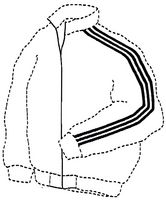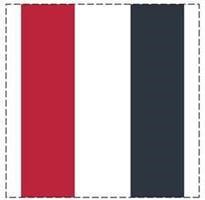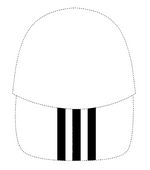Give us a call
Free initial assessment of your case
What can we do for you? Call us without obligation or send us your warning by email or via our contact form.
Your Contact: Thomas Seifried, German Attorney at Law (Rechtsanwalt) and Specialist for Intellectual Property Rights (Fachanwalt für gewerblichen Rechtsschutz)
Contact us
Free initial assessment
Our initial consultation in trademark law is free of charge.
+49 69 9150760
Here you can send us your documents. We will treat your request strictly confidential.
Adidas trademarks
Adidas is the owner of several hundred trademarks. However, in court cases, especially when it comes to clothing with two stripes, only a few of them play a practical role. Two of these brands are shown here.


Was the three-stripe of adidas trademark actually infringed?
Adidas SE warns against offers of two-stripe clothing. This concerns sportswear (cf. OLG Munich, judgment of 26.7.2001 - 29 U 2361/97 - Drei Streifen-Kennzeichnung; in the result also: ECJ, judgment of 10.4.2008 - C-102/07 - adidas AG/Marca Mode, C&A, H&M, Vendex) as well as other clothing. Whether a trademark has been infringed depends on several factors:
- Is there any likelihood of confusion
- In the case of composite marks ("combination marks"), e.g. a word/figurative mark, has the influence of the respective sign components and the scope of protection of the overall sign been correctly determined?
- Is the use of the mark perhaps even allowed in your case, e.g. because the sign was not "used as a trademark"?
Therefore, never sign hastily, even if the deadlines have been set tightly. Once you have issued the cease-and-desist declaration, you cannot subsequently claim that an infringement does not constitute a trademark infringement.
We can usually quickly identify whether the asserted claims and warning costs are justified and enforceable. Even in the case of justified warnings, we can often significantly reduce the warning costs and any claims for damages.
No likelihood of confusion between Thom Browne trade mark and Adidas three-stripes trade mark
EUIPO, Decision of 26/01/2024 Opposition B 3 044 594 - Adidas AG v Thom Browne, Inc.
On 10/11/2017, Thom Browne, Inc. applied for the following figurative mark, inter alia, for goods in classes 18 (leather goods) and 25 (clothing).

Adidas AG filed an opposition against this. There was a likelihood of confusion with the above-mentioned EU trademark 003517588 (position mark). There was also a likelihood of confusion with three other three-stripe trade marks, namely
- the EU trade mark 3517646 for shoes reproduced above and
- the EU trade mark No. 4269072 for headgear (class 25) and
- Benelux trade mark 300806 for leather goods (Class 18), footwear and clothing (Class 25).


Increased distinctiveness of the Adidas trade marks
The EUIPO first found that the Adidas trade marks had acquired a highly distinctive character and reputation in the European Union, including Germany and the Benelux countries, for sportswear and footwear, but not for leather goods (Class 18).
However, there is no likelihood of confusion between the Thom Browne trade mark and the Adidas trade marks. It is true that the opposing goods are identical. However, the signs are only visually similar to a limited extent, insofar as they have basic elements such as stripes in common. However, the arrangement and colors of the stripes in the signs are different. Consumers are able to perceive differences in the design of the signs. The decisive factor is how the signs in question are normally perceived as a whole and not how the stylistic differences between the signs can be perceived when a particularly careful consumer examines the graphic design and makes comparisons between them. In the overall visual assessment of the conflicting trade marks, despite certain similarities, the differences between them predominate and lead to a sufficiently distant visual impression.
No protection of reputation either
The EUPIO did grant the Adidas trade marks protection as well-known trade marks due to their high reputation. However, due to the lack of similarity between the conflicting signs, the EUIPO also rejected any detriment to the distinctive character or repute of the well-known Adidas trade marks.
> DOWNLOAD: Decision of the EUIPO of 26.1.2024 - Opposition B 3 044 594
More on the subject: Adidas does not have to tolerate application for a two-stripe position mark
EuGH 17.02.2016 – C-396/15 – Shoe Branding Europe BVBA / adidas AG u.a.
On July 1, 2009, Shoe Branding filed an application for the Community trademark (now: Union trademark) shown above in the form of a position mark for footwear. The application claimed protection for a mark on a sports shoe with the two stripes shown in the position depicted. The shape of the shoe itself was not to be protected. The adidas company filed an opposition to this application, essentially on the grounds of likelihood of confusion with its own earlier position mark for footwear. This looks like this:

The Office for Harmonization in the Internal Market (now: European Union Intellectual Property Office - EUIPO) rejected the opposition. The Board of Appeal of the Office also rejected the appeal filed against this decision. The conflicting signs were dissimilar. The reasonable well-informed public would not be able to confuse the opposing two-stripe design with the three-stripe design. This decision was challenged by adidas in an action before the General Court of the European Union. The latter essentially upheld adidas and annulled the decision of the Board of Appeal. Shoe Branding, in turn, appealed this decision to the European Court of Justice.
ECJ: Number of stripes unimportant
The ECJ rejected the appeal and confirmed the decision of the CFI. The latter had stated: The average, prudent, reasonable and well-informed consumer is averagely observant when it comes to buying sports shoes. The differences in skewness and positioning would require a closer examination in order to recognize them. In turn, the number of stripes would not be important to the average consumer (CFI - T-145/14 - adidas AG v OHIM and Shoe Banding BVBA, para. 40). The likelihood of confusion was not excluded by the differences in the number, angle, length and position of the stripes of the Shoe Branding mark.
What the average consumer perceives is judged by the factual authority and not by the ECJ
What the average consumer perceives is judged by the factual authority and not by the ECJ
Shoe Branding first challenged the lower court's view that the purchaser of sportswear is not very attentive because they are everyday consumer goods. The ECJ considered this argument, that the average buyer of sportswear is very well able to distinguish between different sports brands due to his special attention, contrary to the opinion of the lower court, already inadmissible. The assessment of the consumer's attention was a question of fact and therefore not a matter for the ECJ (because the latter may only decide questions of law). The clarification of facts, however, is the task of the lower court. However, the lower court had just found that the consumer is on average attentive, prudent, reasonable and well-informed when it comes to buying sports shoes. Therefore, the reasoning with which a likelihood of confusion was assumed was also not objectionable. On the contrary, the Court of First Instance of the European Union also took into account the differences between the two marks. It also found that there was a likelihood of confusion between the two marks because it correctly based its finding on the overall impression.
Indication for infringement case
The ECJ had to decide here in opposition proceedings, not in infringement proceedings. In opposition proceedings, the issue is whether the owner of an earlier trademark must tolerate the registration of a younger trademark. In infringement proceedings, the issue is whether a trademark owner must generally tolerate the use of another sign (whether registered or not). The BGH has indicated in the past that stricter standards are to be applied in assessing whether a trademark owner must tolerate a younger trademark that is likely to cause confusion in opposition proceedings than in infringement proceedings. This is because in these cases the younger applicant itself seeks a permanent right to register, which it can transfer and license (BGH v. 2.4.2015 - I ZR 59/13, para. 48 - Springender Pudel).
In the present case, however, there is much to suggest that infringement courts would also consider the Shoe Branding shoes to infringe adidas' well-known three-stripe mark. Decisions in which two-stripe markings were regarded as infringement of adidas trademarks have in any case existed for some time (e.g.: OLG München v. 26.7.2001 - 29 U 2361/97 - Drei-Steifen-Kennzeichnung; in the result also ECJ v. 10.4.2008 - C-102/07 - adidas AG/Marca Mode, C&A, H&M, Vendex).
Years of experience and proven success
We have years of experience and a proven track record in trademark law.


